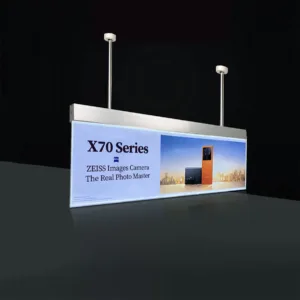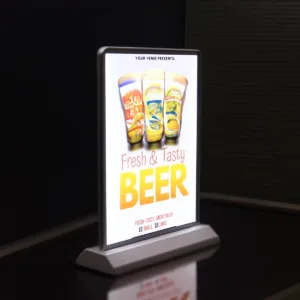Table of Contents
Introduction
Businesses are increasingly upgrading their lighting solutions to LED due to its substantial benefits over traditional technologies. This post will analyze the cost and benefits of transitioning from fluorescent to LED lightboxes.
The Case for Upgrading to LED
Upgrading to LED lightboxes is driven by several factors:
- Energy Efficiency: LEDs consume significantly less power than fluorescent lights.
- Longer Lifespan: LEDs can last up to five times longer than fluorescent bulbs, reducing replacement costs.
- Better Quality Light: LEDs provide clearer, more vibrant lighting for displays, enhancing visual marketing efforts.
Comparing Fluorescent and LED Lightboxes
Key comparisons include:
- Energy Consumption: LEDs use about 50% less energy than fluorescent lights, leading to lower utility costs.
- Lifespan: LEDs typically last between 35,000 to 50,000 hours, compared to about 10,000 to 15,000 hours for fluorescent lights.
- Upfront Costs: LED lightboxes are generally more expensive initially but offer savings over time due to reduced energy and maintenance costs.
Energy Efficiency and Cost Savings
LEDs are more energy-efficient than fluorescent bulbs, translating into direct cost savings:
- Electricity Usage Reduction: LEDs can save about 40% to 60% on energy costs when replacing fluorescents.
- Annual Energy Cost Savings: Depending on the usage, switching to LED can save a considerable amount annually per lightbox.
- Cumulative Savings: Over their lifespan, LEDs offer significant savings due to lower energy consumption and maintenance costs.
Maintenance and Replacement Costs
LED lightboxes have lower maintenance costs due to their longer lifespan and durability:
- Bulb Replacement: Fluorescent bulbs need frequent replacements, which is costly and labor-intensive.
- Maintenance Needs: LEDs require less maintenance, resulting in lower long-term costs.
Upfront Investment and ROI
While the initial cost for LED lightboxes is higher, the return on investment is favorable:
- ROI Calculation: The payback period for LED upgrades can be as short as 2-3 years, depending on energy savings and maintenance costs.
- Rebates and Incentives: Many utility companies offer rebates for energy-efficient LED installations, further reducing upfront costs.
Environmental Impact and Sustainability
LEDs contribute positively to environmental sustainability:
- Reduced Carbon Emissions: Lower energy consumption means fewer carbon emissions.
- Hazardous Materials: LEDs do not contain mercury, unlike fluorescent bulbs, reducing toxic waste.
Case Studies: Successful LED Lightbox Upgrades
Several businesses have reported benefits from upgrading to LED lightboxes:
- Energy and Cost Savings: Documented reductions in energy use and maintenance costs.
- Enhanced Lighting Quality: Improved display aesthetics and visibility have enhanced customer experiences.
Conclusion
The transition from fluorescent to LED lightboxes represents a wise investment for businesses aiming for sustainability and cost efficiency. The upfront costs are offset by the long-term savings and environmental benefits, making LED a superior choice for modern lighting needs.
 Explore our energy-efficient LED lightbox solutions
Explore our energy-efficient LED lightbox solutions
Related Articles:
- Comparing LED Lightboxes with Emerging Display TechnologiesIntroduction The display technology landscape is rapidly evolving, presenting a wealth of options beyond traditional LED… Read more: Comparing LED Lightboxes with Emerging Display Technologies
- The Evolution of LED Lightbox Technology Over the Last DecadeIntroduction Over the past decade, LED lightbox technology has undergone significant transformation, driven by advancements in… Read more: The Evolution of LED Lightbox Technology Over the Last Decade
- Preventative Maintenance Schedule for LED LightboxesIntroduction Maintaining your LED lightboxes is crucial to ensure their longevity and optimal performance. This guide… Read more: Preventative Maintenance Schedule for LED Lightboxes










